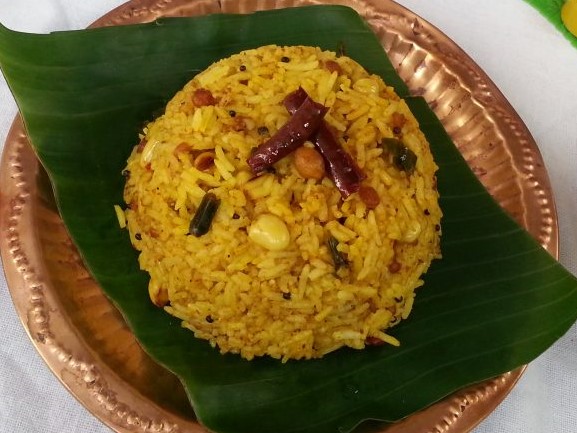Tamarind Rice
Spicy Tangy Rice
It is an age old dish and is often served in temples as a prasada
Introduction
About this Recipe
Also called Puliyodharai (Tamil), Puliyogare (Kannada)
Tamarind rice is a healthy and popular dish prepared on auspicious occasions such as Ganesh Chaturthi and Diwali. It is an age old dish and is often served in temples as a prasada. This is one of the dishes linked with the people of the Iyengar community.
These days, readymade tamarind paste for this preparation is available in stores. But nothing can be compared with cooking it fresh which gives the full benefit of the prasada. Also as an alternative people use brown rice to prepare the Tamarind rice.The hot taste usually depends on the pungency of the red chillies. Therefore, you may want to check the spiciness before adding the red chillies. Also, if you want the rice to be more sour, you can add more tamarind as per your taste. To make it more interesting for children, vegetables, peanuts, cashew nuts are added during cooking.
Though it takes more than an hour to prepare the Tamarind rice, families do enjoy taking time to prepare it as it is widely enjoyed by all ages of people from young to old.
Sharings of Supreme Pontiff of Hinduism (SPH) Jagatguru Mahasannidhanam His Divine Holiness Nithyananda Paramashivam on Tamarind Rice
In one of the satsang dated 20th November 2014 SPH mentions, “Even now my whole life I can run just with a few handfuls of curd rice and tamarind rice and that also I am not dependent on it.”
SPH’s love for tamarind rice can be understood in one of the satsang dated 25th February 2016 where he mentions tamarind in the Upanishads: “Upanishads you are the best turmeric rice, or tamarind rice.”
In another recent satsang on 12th August, 2020 SPH reiterated, “I am addicted to fasting as first priority, Second priority – my great feasting – what kind of meal you will decide to celebrate…in my life is kanchipuram idli with pepper, no salt, all organic ingredients with curry powder or little tamarind rice.
The very speciality of this recipe is that it is one of the most cherished delicious recipes of SPH. It is a simple tangy rice dish made with the flavour of tamarind. Tamarind rice is mainly served as prasadams (offering) in the temples and in all the places where religious ceremonies are held. It’s very common in south Indian homes and meals especially during Navratri festival and Varalakshmi Vratham where special poojas are done for Devi Parashakthi. This is a perfect meal to cook when you want something sour, spicy and easy.
Note:
Bhaga Shastra gives ingredient measurements in measurement systems used in ancient times. Hence please use the conversion guidelines below to convert it into modern measurement systems. When giving this recipe, we are not rounding any measurements in the modern units, so as to avoid any deviations from the Bhaga Shastra.

“It is about absolutely being addicted to the right things which
instigates, inspires healthy existence.
What kind of meal you will decide to celebrate…..
In my life is kanchipuram idli with pepper, no salt;
all organic ingredients with curry powder or little
tamarind rice!”
– SPH JGM Nithyananda Paramasivam
- Preparation time: 15 minutes
- Cooking time: 30 minutes for cooking the rice
- Total time: 1 hour
- Servings : 5 persons
- Course: Main
- Cuisine : South Indian
Ingredients
- Ingredients
- Rice – 250 gms
- Pure Water – 1.1 litres
- Sesame oil – 105 ml
- Tamarind pulp – 70 gms
- Powdered Salt – 17.3 gms
- Red Chilly – 23.3 gms
- Mustard Seeds – 3 gms
- Fenugreek Seeds – 0.8 gms
- Asafoetida 1 pinch
- Turmeric Powder – 0.4 gms
- Curry Leaves – 1.6 gms
Benefits
-
The main ingredients in Tamarind Rice are tamarind and sesame oil – the tamarind helps in detoxifying our body and blood, and also strengthens our nervous system. Sesame oil promotes bone health, prevents tooth decay and reduces cholesterol levels. Together, both the main ingredients help in spiritual expansion. The benefits of tamarind rice includes reduction in weight and improves your eyesight. Besides that tamarind also aids in digestion and stomach related issues.
If the tamarind rice is tied up tightly and stored in an areca leaf, it can remain unspoiled for 10 to 15 days. This is the reason why it is a preferred food travellers like to carry along during long journeys.
Cooking Method
- Take water in a mud pot and boil it over a stove.
- When the water starts boiling, add the washed rice. After adding the washed rice into the boiling water, close it with the lid and allow the rice to get cooked.
- After a few minutes of adding the rice, you will see because of closed lid cooking, the steam pushes the lid off. Therefore, remove the lid and allow the rice to cook without the lid.
- Check if the rice is cooked. Remove from the stove. Drain the excess water.
- After draining the water, transfer the rice on a clean plate.
- When the rice is still hot, spread a small quantity of the sesame oil evenly over the cooked rice and mix it gently.
- In another bowl, take 300 ml of water, and add the tamarind and allow it to soak for a few minutes.. Then, squeeze the tamarind as much you can to extract the juice out of it.
- Filter the tamarind juice through a strainer into another bowl to remove and discard the residue of seeds, etc. Now, the tamarind juice has been extracted.
- Next, add the powdered salt to the tamarind juice, mix it and set it aside.
- Heat the kadai and add 70 ml of sesame oil in it. When the oil becomes hot, add the red chillies. Stir the red chilli and allow it to fry a little.
- Next add the mustard seeds, fenugreek seeds and asafoetida. Stir all these ingredients in the oil until the mustard seeds get spluttered.
- Add turmeric powder and curry leaves and mix gently with the tip of the ladle.
- Now, add the tamarind juice. Keep stirring continuously so that the sediment doesn’t settle at the bottom of the kadai.
- Cook till all the water gets completely absorbed into the mixture, and all the components come together to a paste like consistency. This will take about 5-10 minutes.
- Once all the moisture in the kadai has evaporated, the oil will ooze from the corners of this mixture. This is the perfect consistency. Now the tamarind paste is ready.
- Add this tamarind paste to the rice that has been spread on the plate for cooling. Mix thoroughly with the ladle, so that all the ingredients coat the entire rice nicely.
- Now the tamarind rice is ready to be served. It can be served along with koozh vada or papad for the best taste!
Step by step instructions
step 1
Ingredients
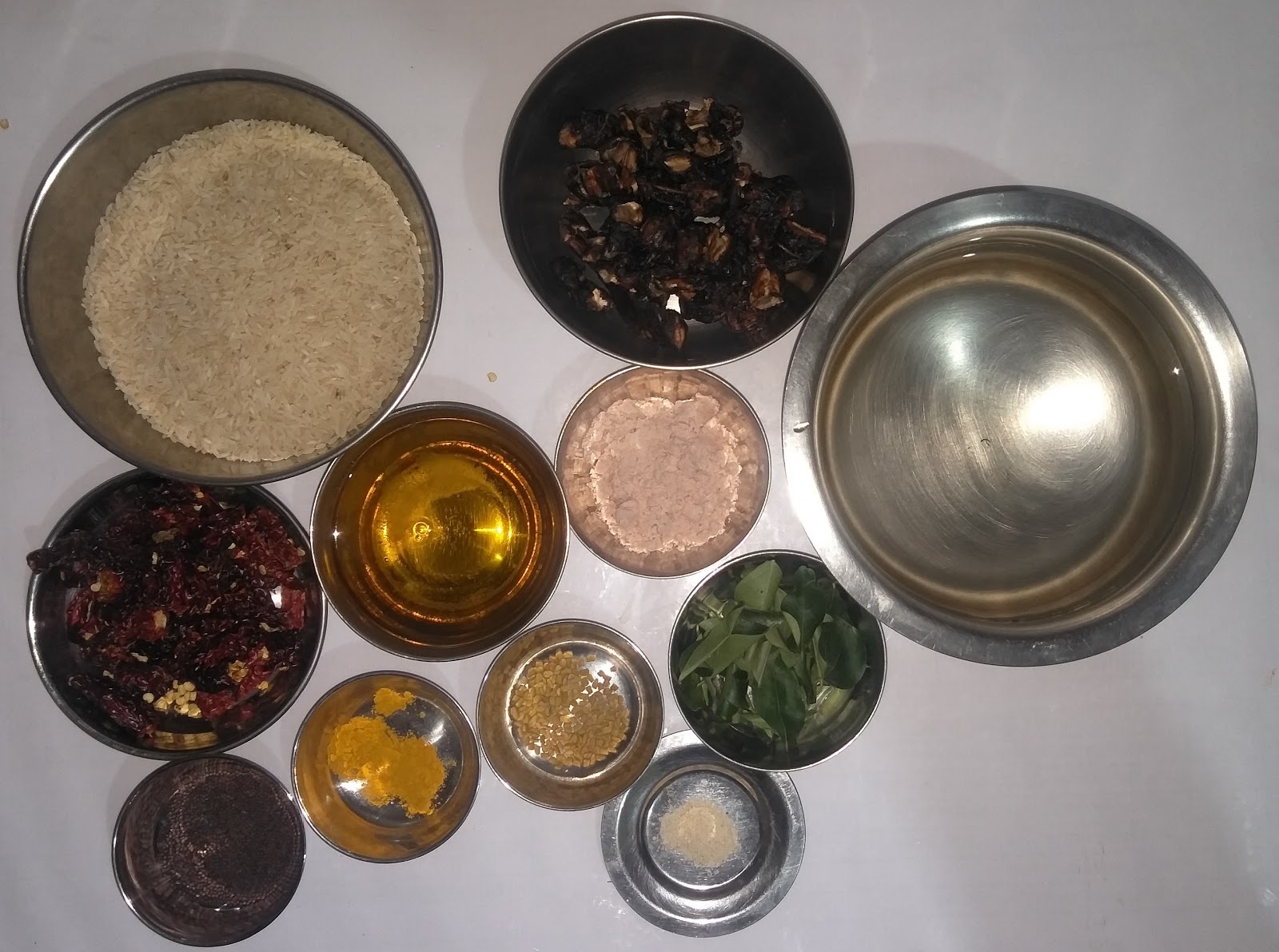
2
Take water in a mud pot, place it over a stove and allow the water to boil.
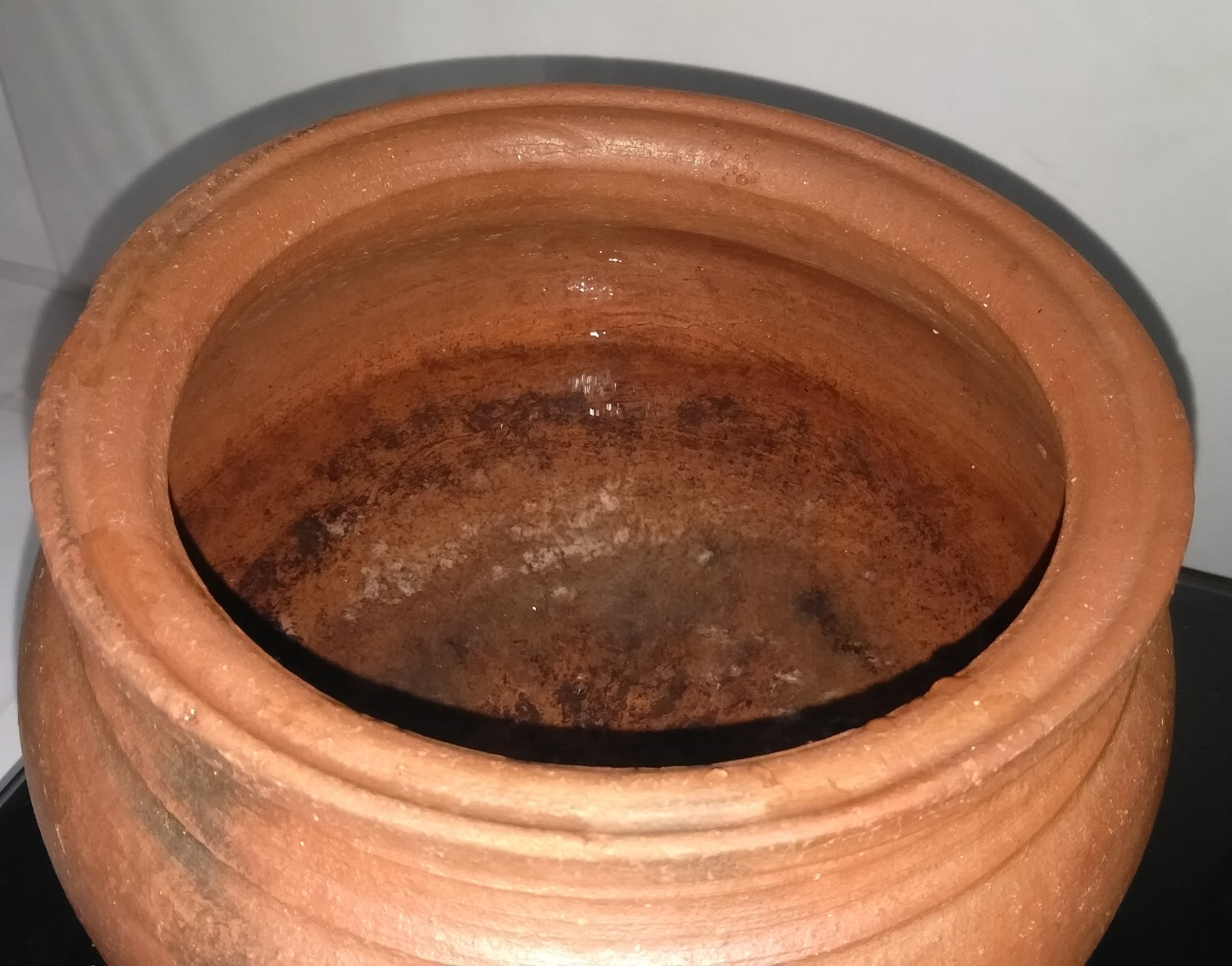
3
When the water starts boiling, add the washed rice, close it with a lid and allow the rice to get cooked.
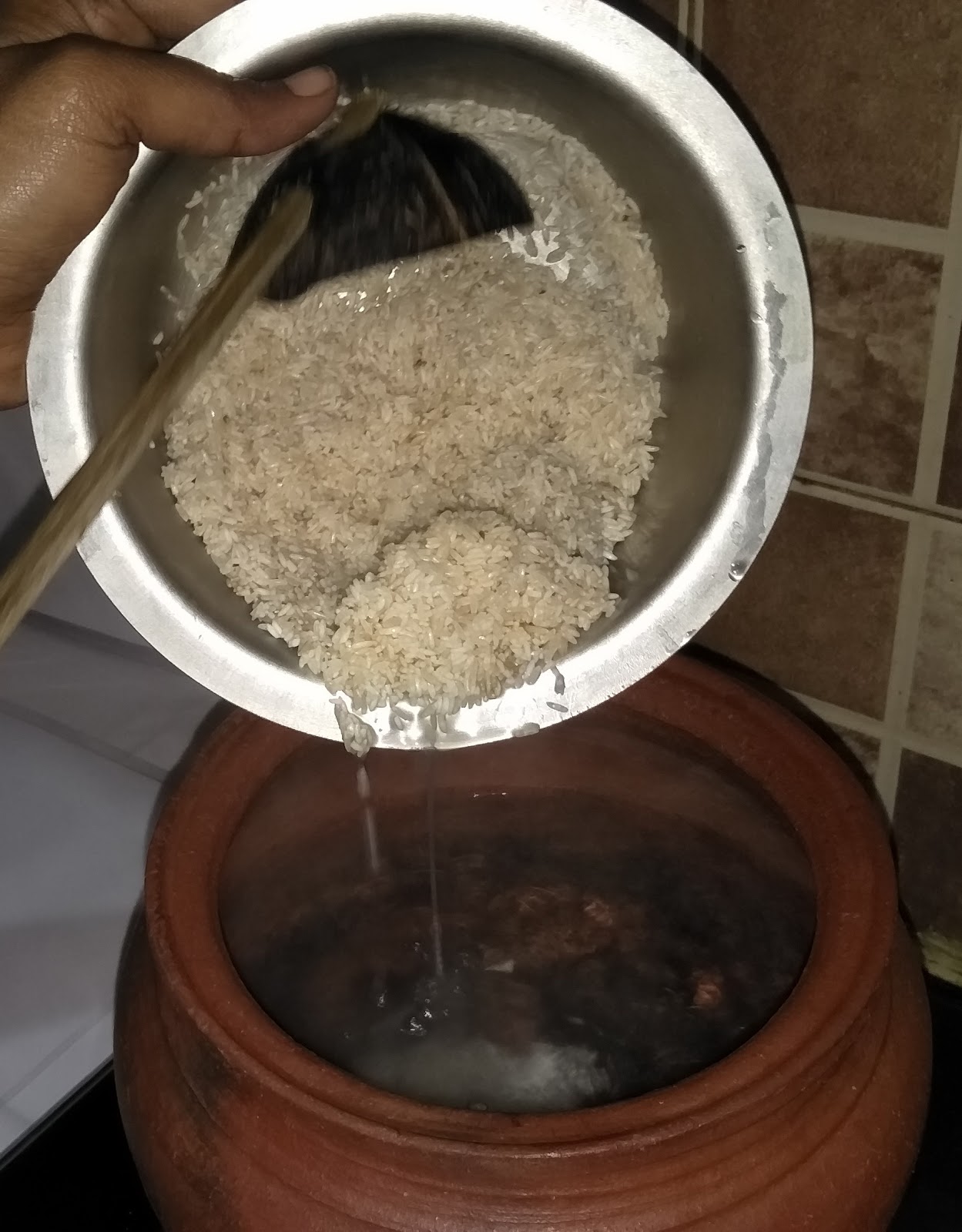
4
Due to close lid cooking, the steam pushes the lid off. So, remove the lid and allow the rice to cook without the lid.
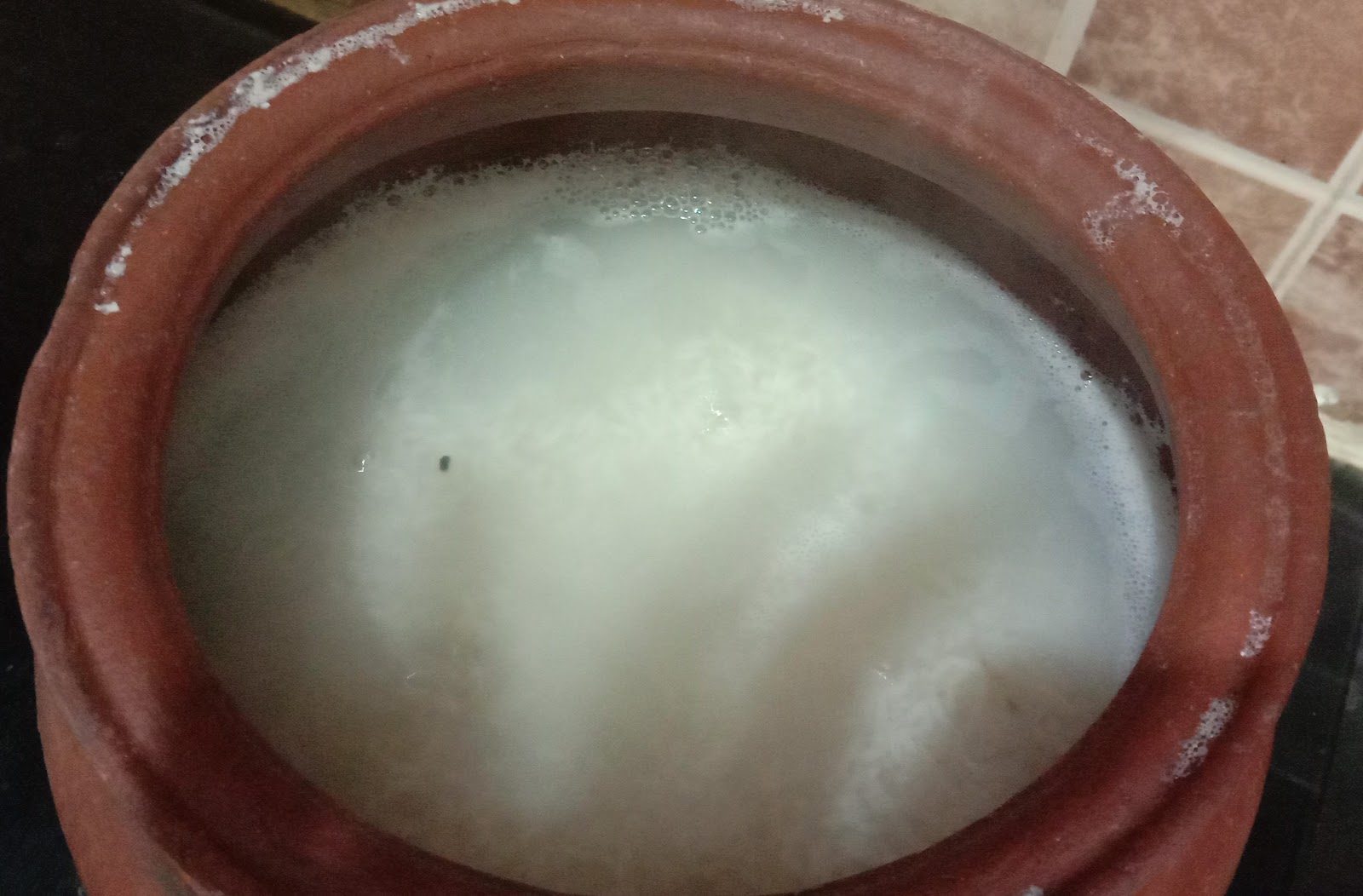
5
Check if the rice is cooked. Remove from the stove. Drain the excess water

6
After draining the water

7
Transfer the rice on a clean plate
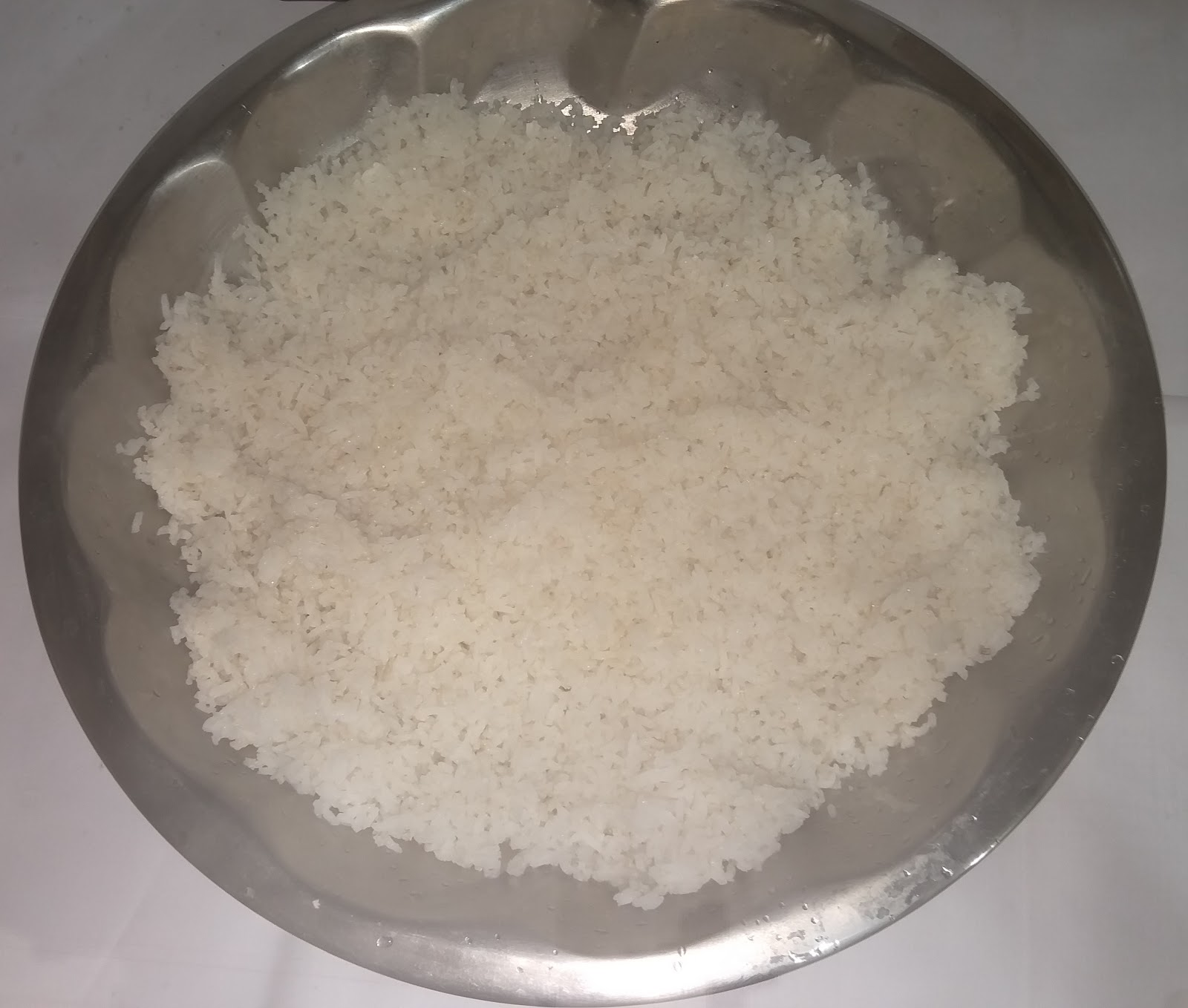
8
When the rice is still hot, spread a small quantity of the sesame oil evenly over the cooked rice and mix it gently.
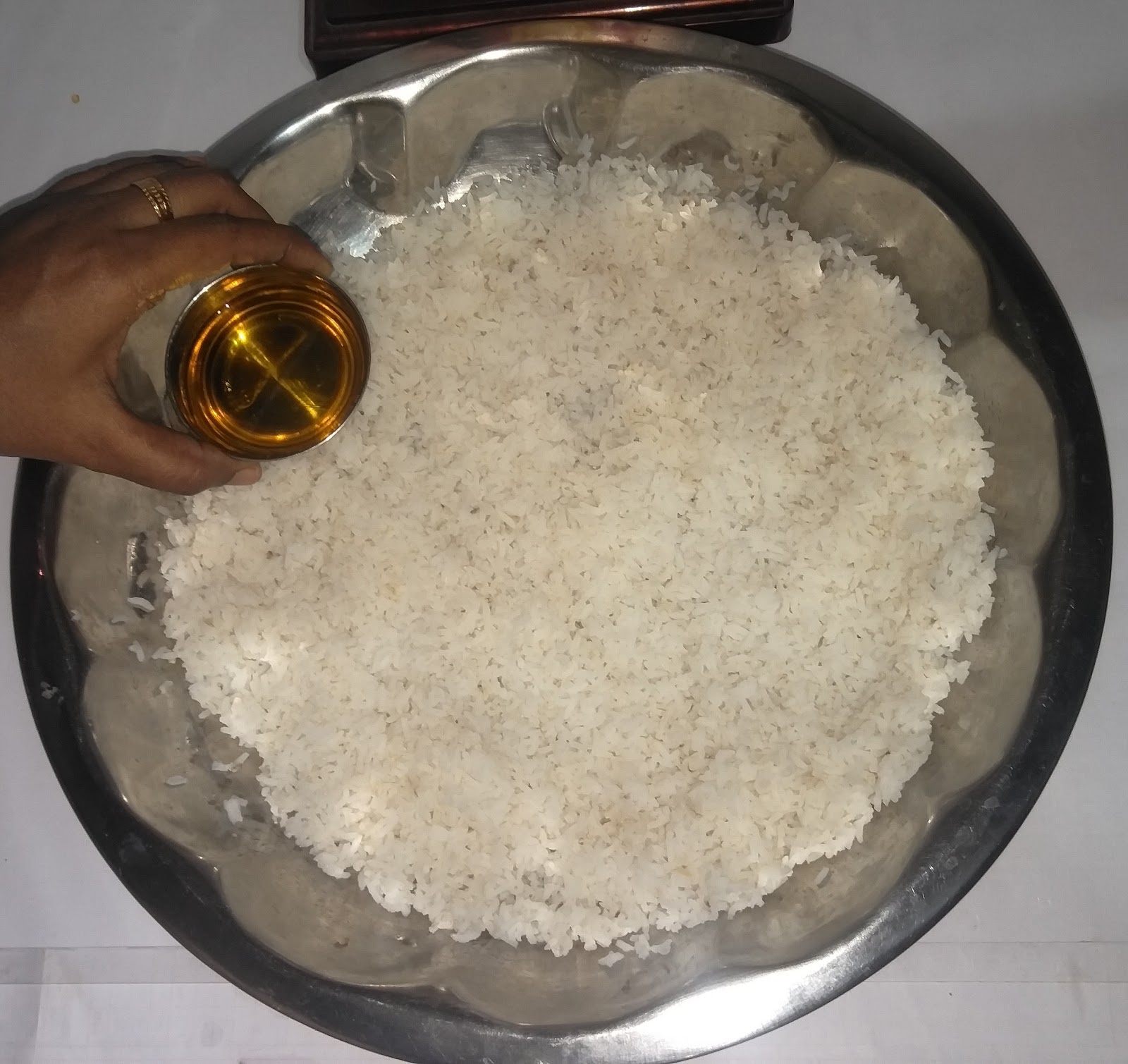
9
In another bowl, take 300 ml of water, and add the tamarind and allow it to soak for a few minutes..
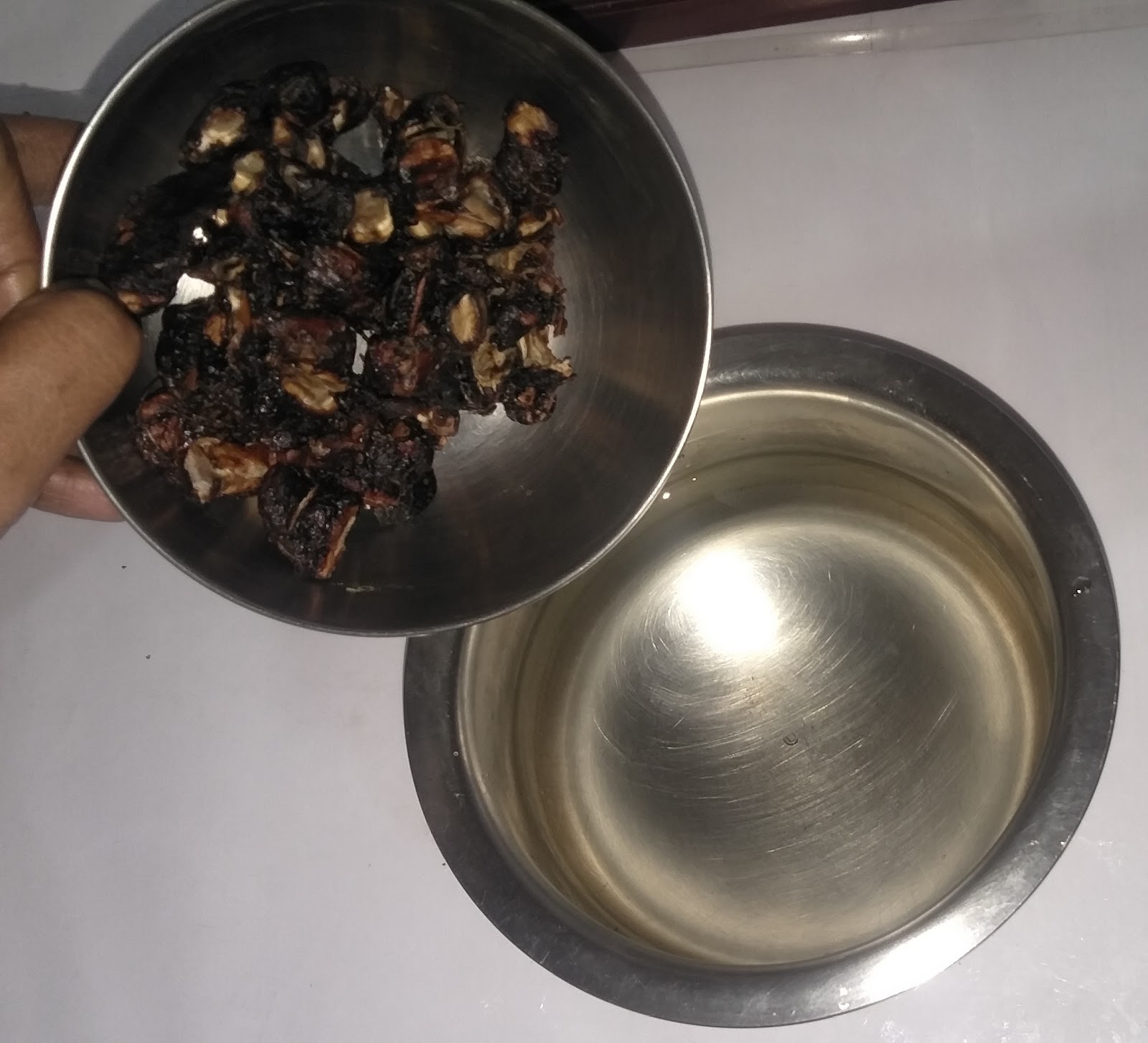
10
Squeeze the tamarind to extract the juice out of it. Filter the tamarind juice through a strainer into another bowl to remove and discard the residue of seeds, etc. Now, the tamarind juice has been extracted.
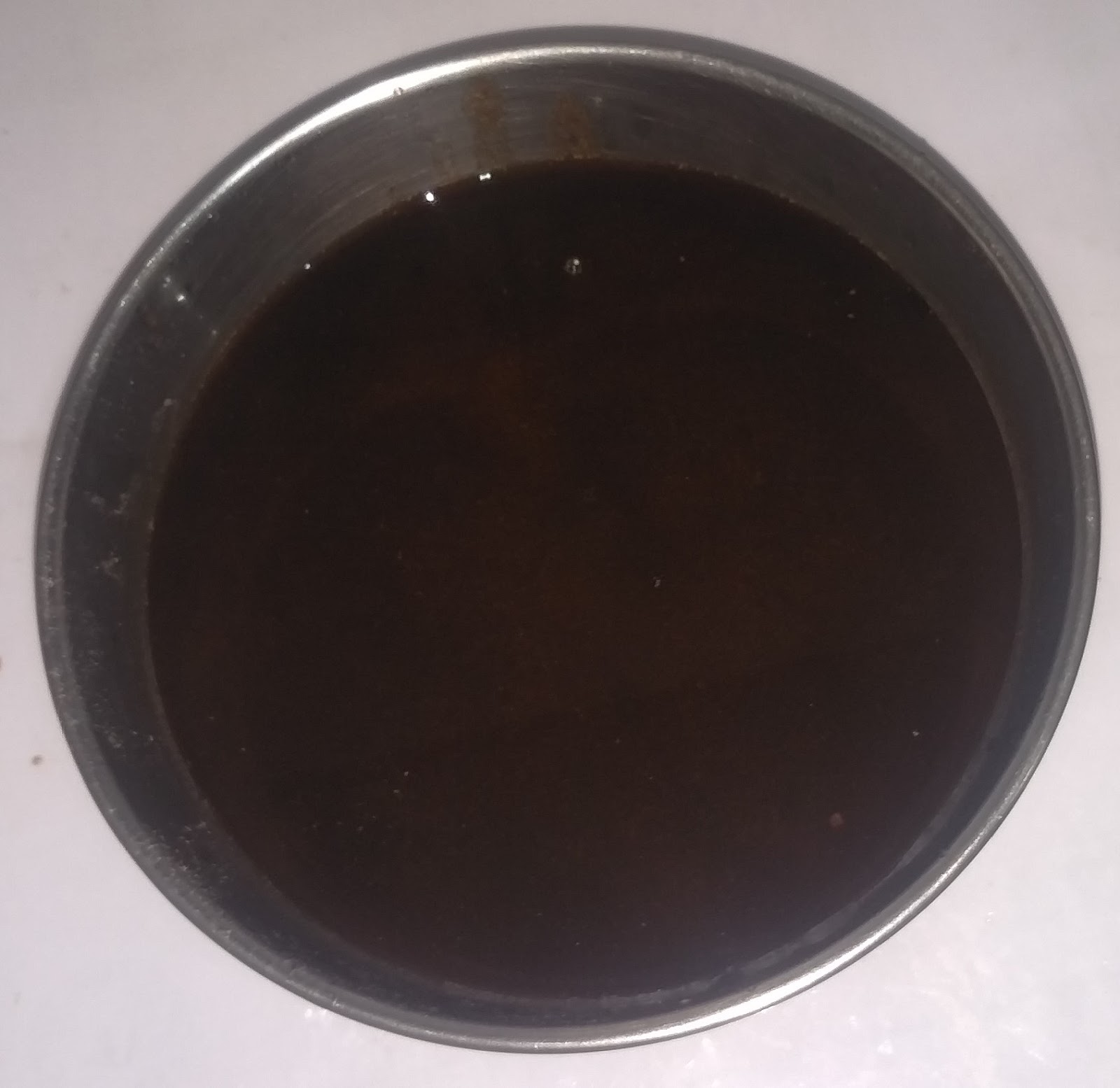
11
Add the powdered salt to the tamarind juice, mix it and set it aside.
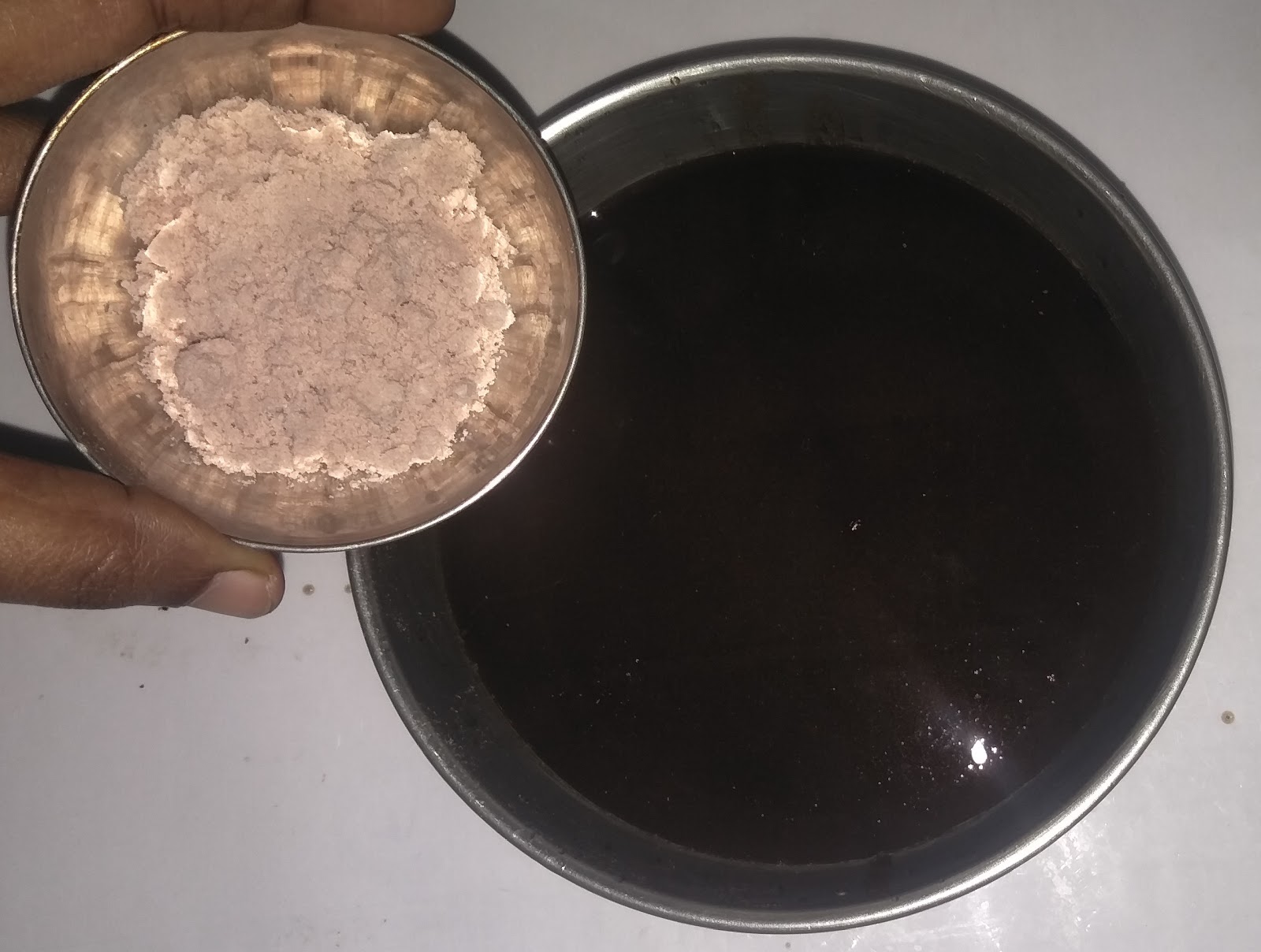
12
Heat the kadai and add 70 ml of sesame oil in it.
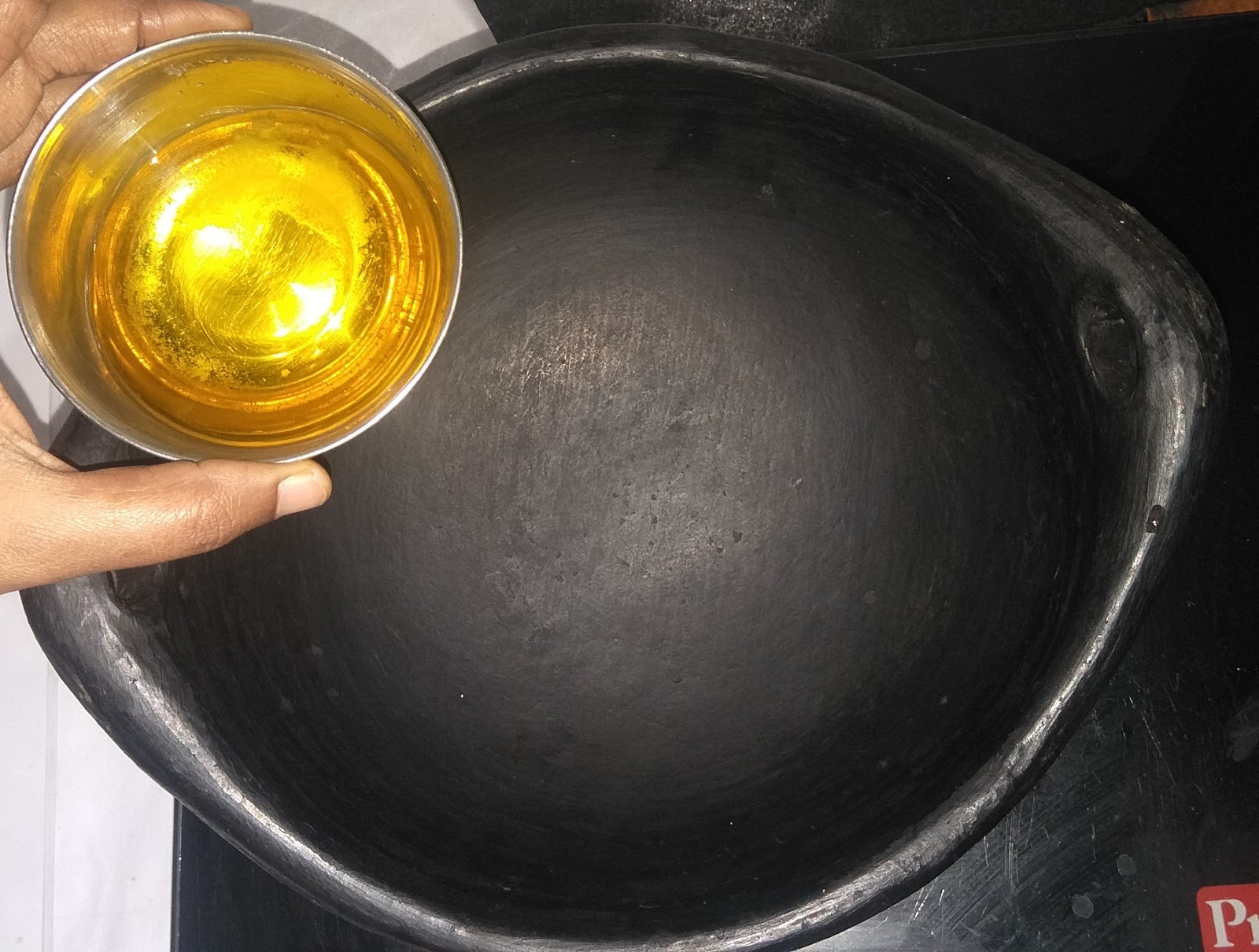
13
When the oil becomes hot, add the red chillies. Stir the red chilli and allow it to fry a little.
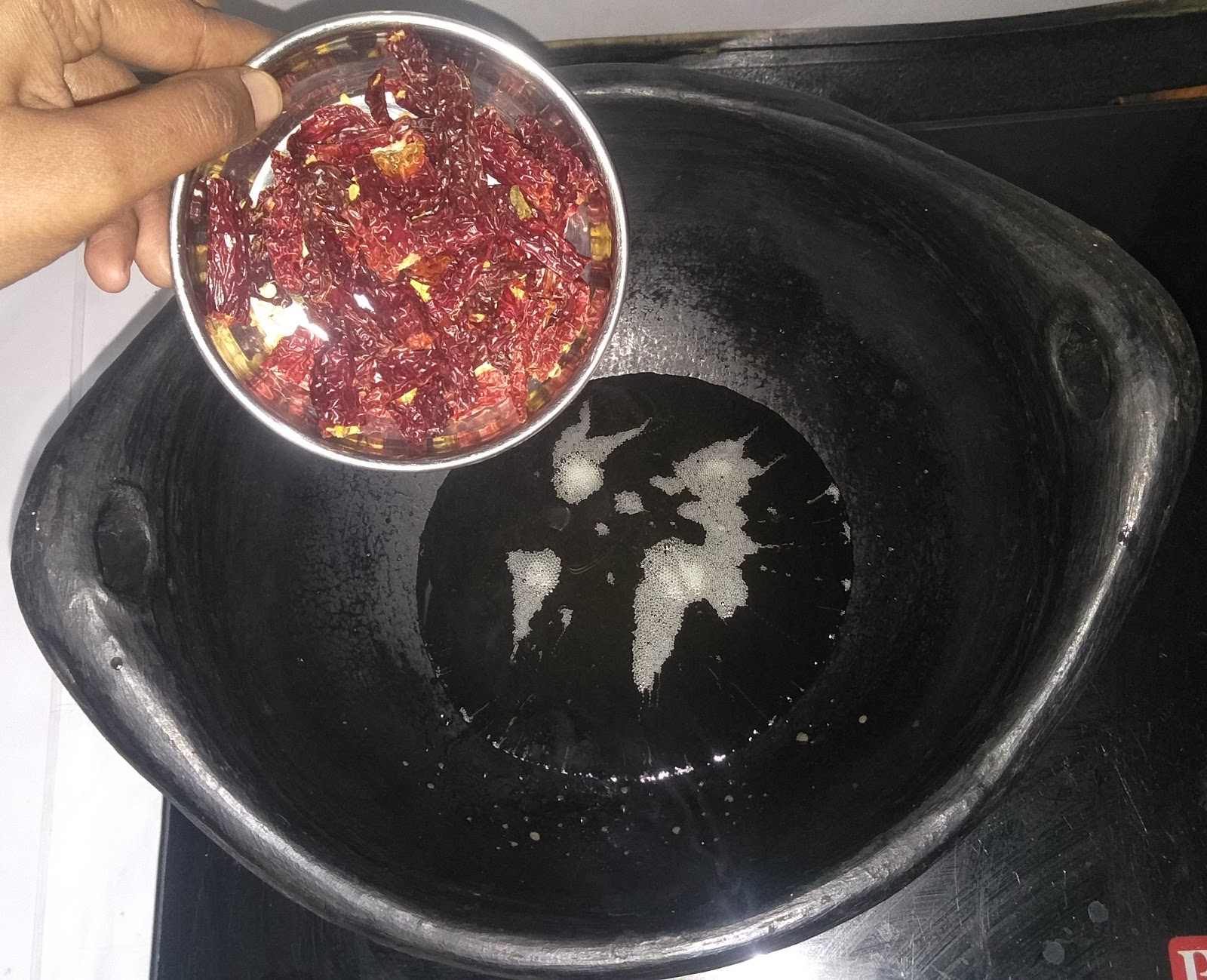
14
Next add the mustard seeds, fenugreek seeds and asafoetida.
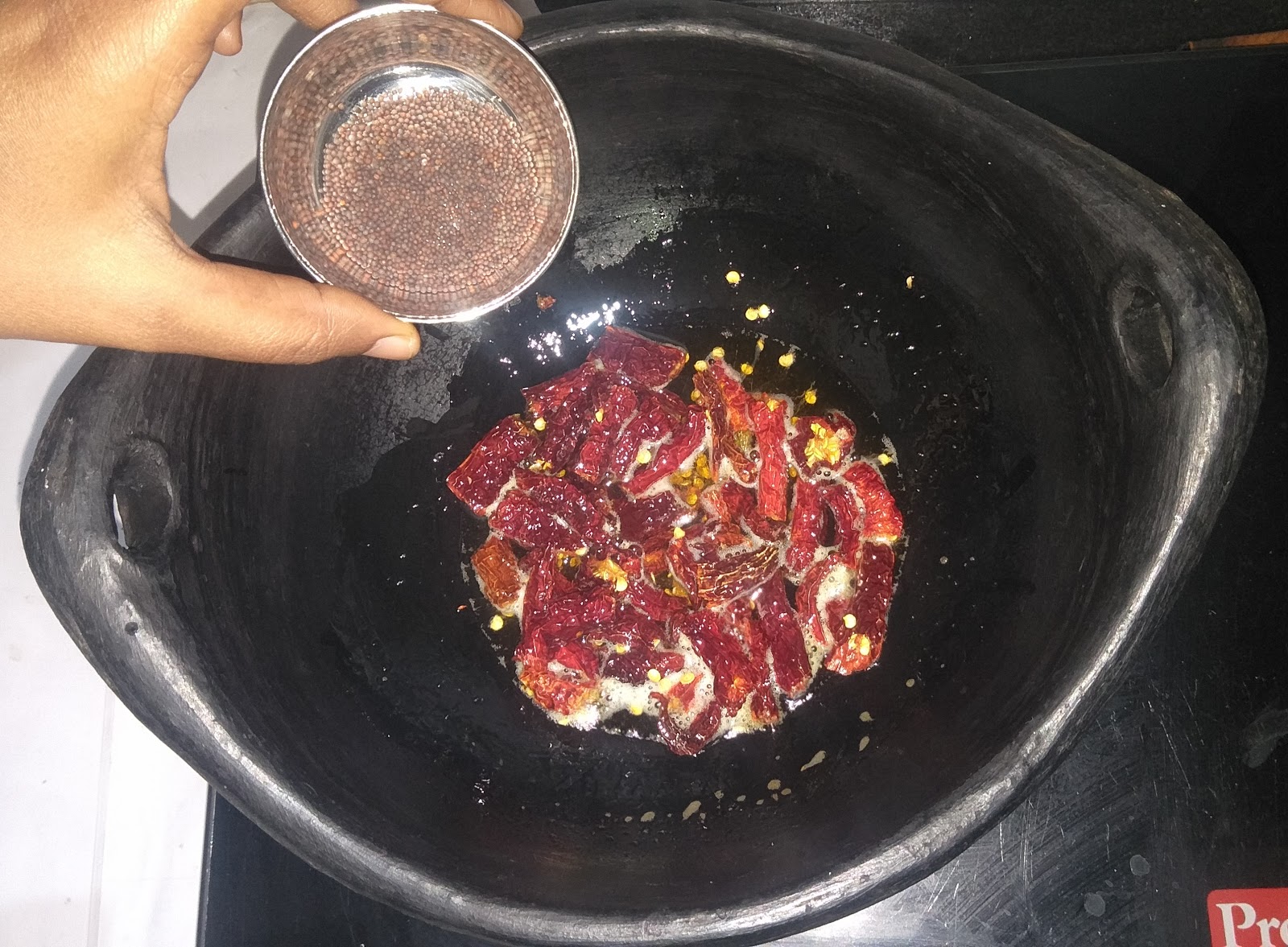
15
Stir all these ingredients in the oil until the mustard seeds get spluttered.

16
Add turmeric powder.
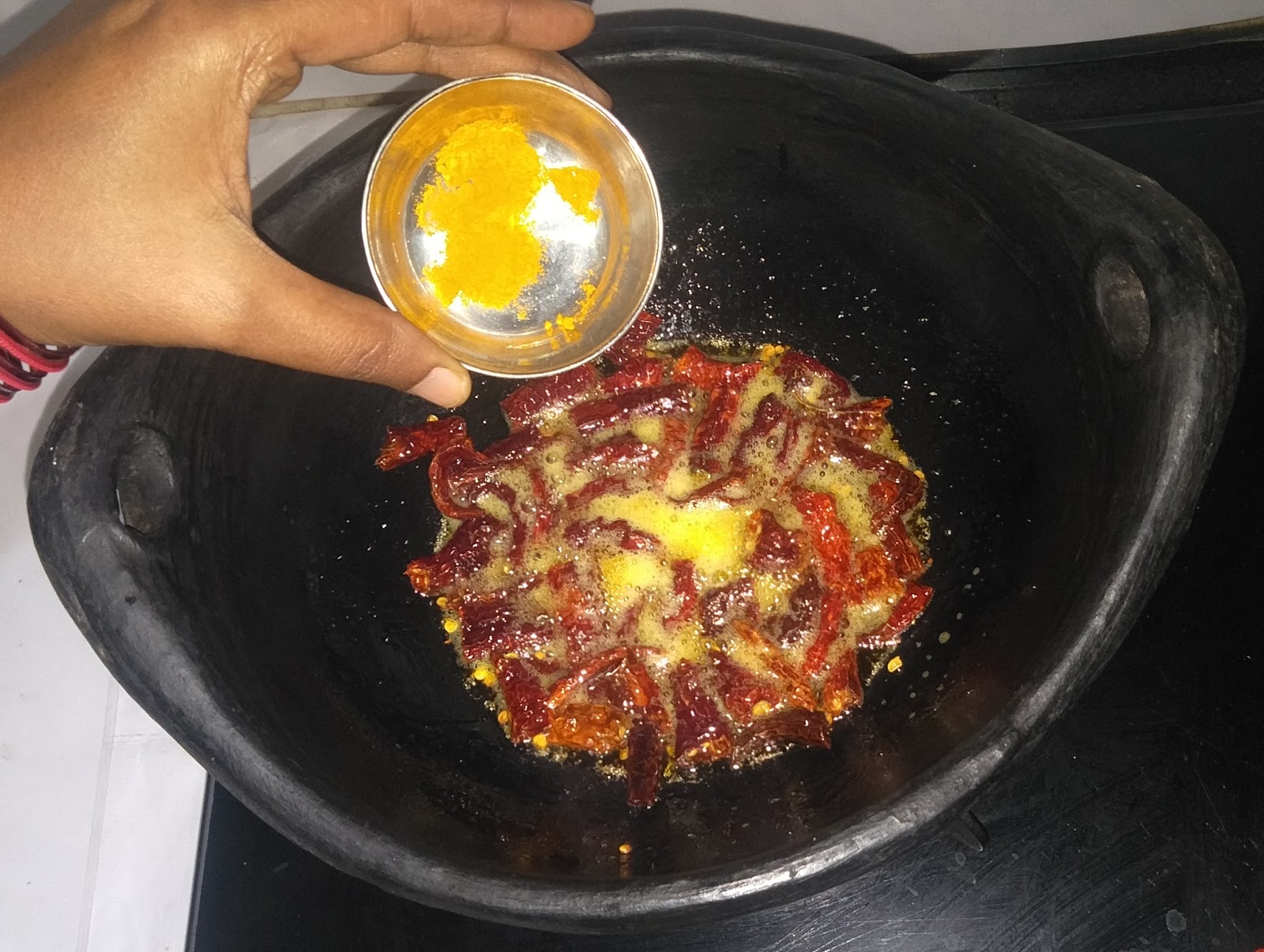
17
Add curry leaves and mix gently with the tip of the ladle.
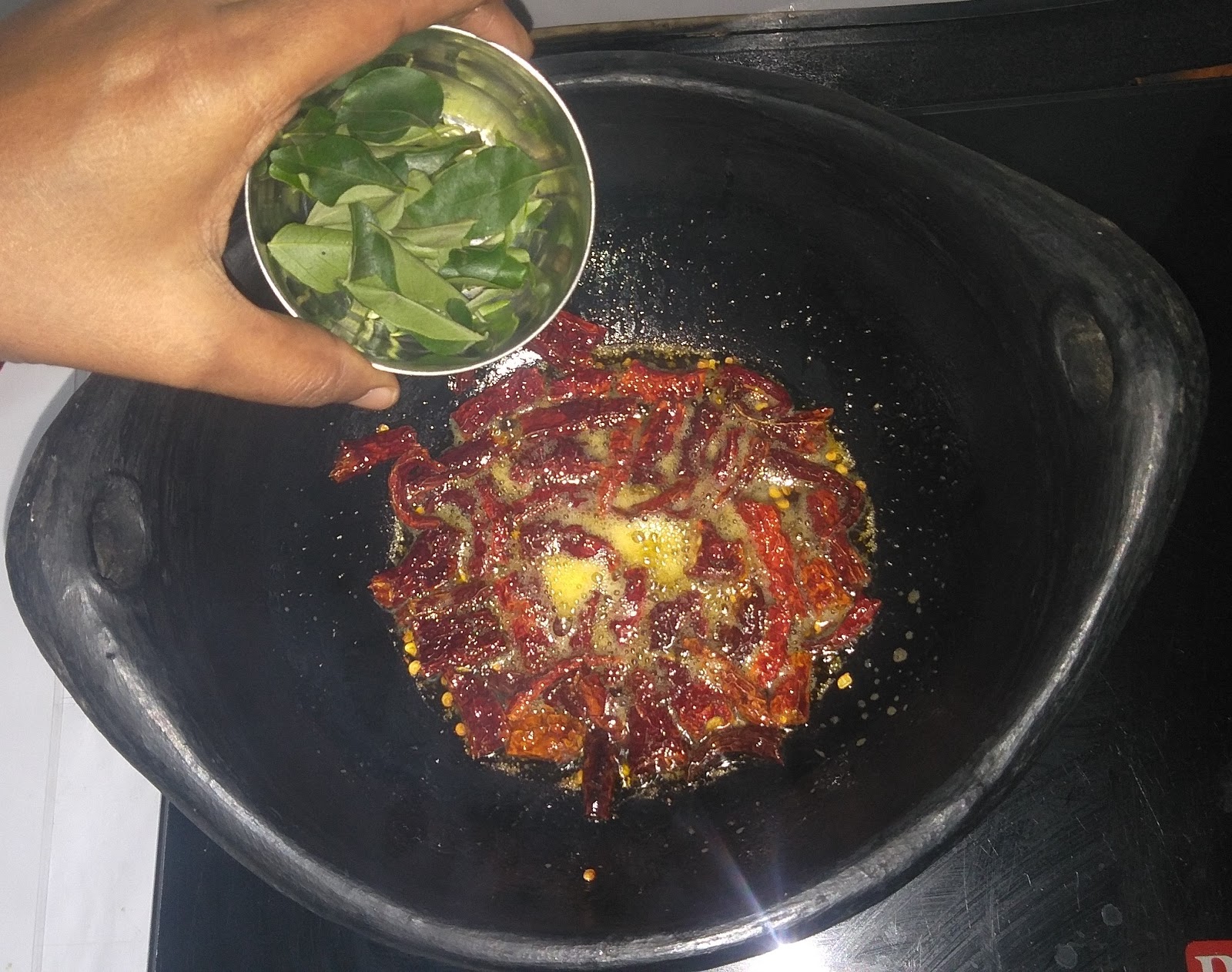
18
Now, add the tamarind juice. Keep stirring continuously so that the sediment doesn’t settle at the bottom of the kadai.
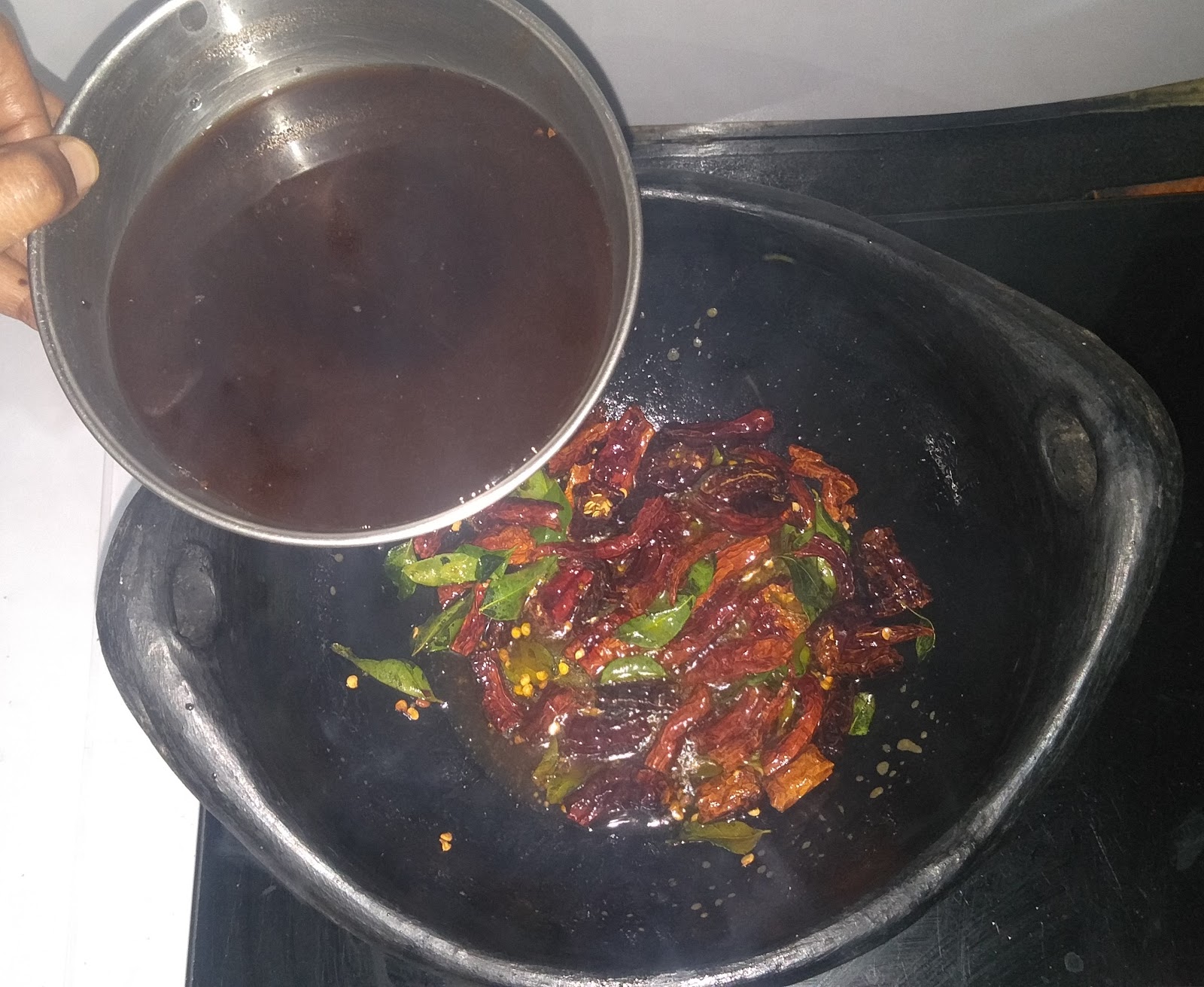
19
Cook till all the water gets completely absorbed into the mixture. Cook till all the components come together to a paste like consistency. This will take about 5-10 minutes.
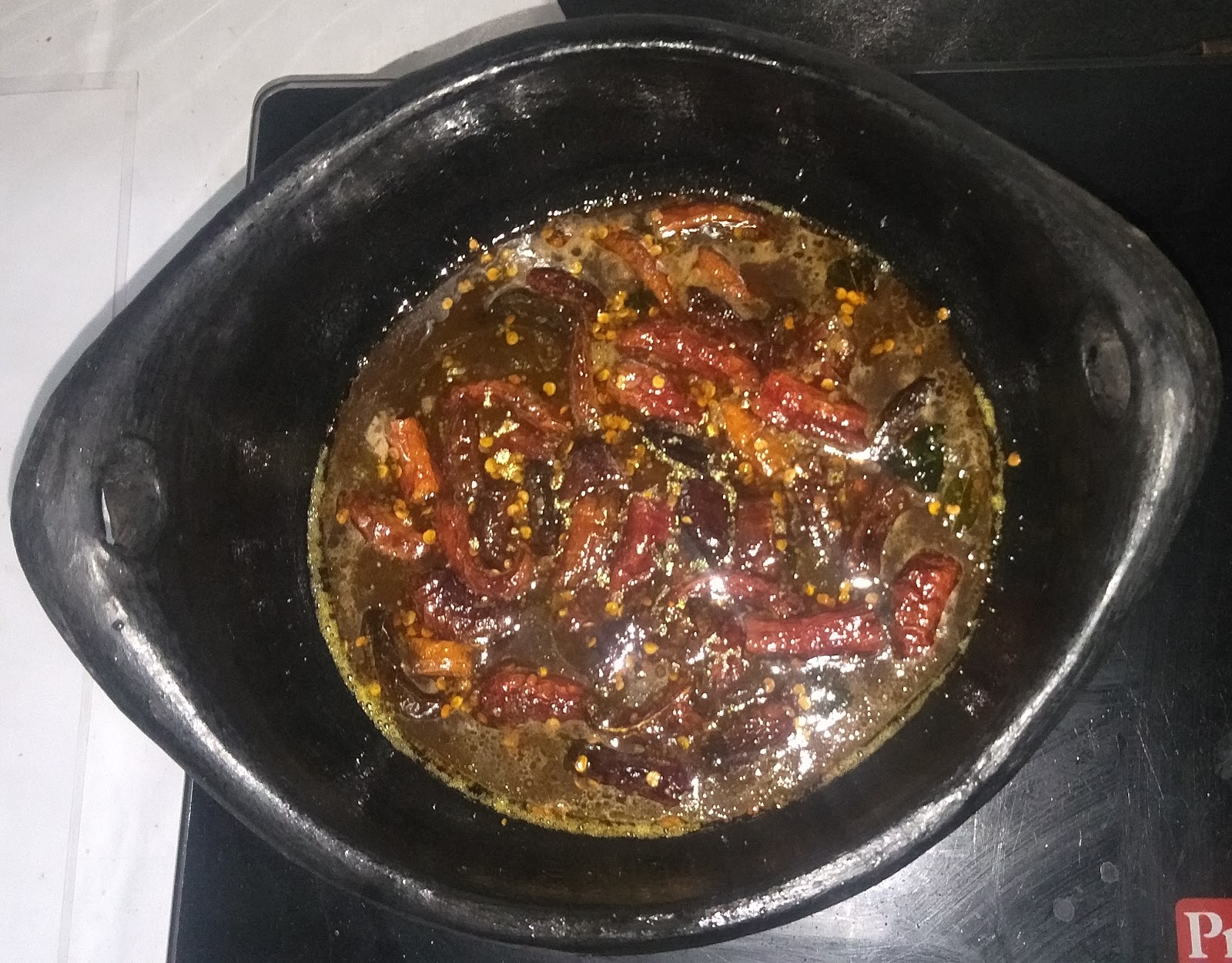
20
Once all the moisture in the kadai has evaporated, the oil will ooze from the corners of this mixture. This is the perfect consistency. Now the tamarind paste is ready.
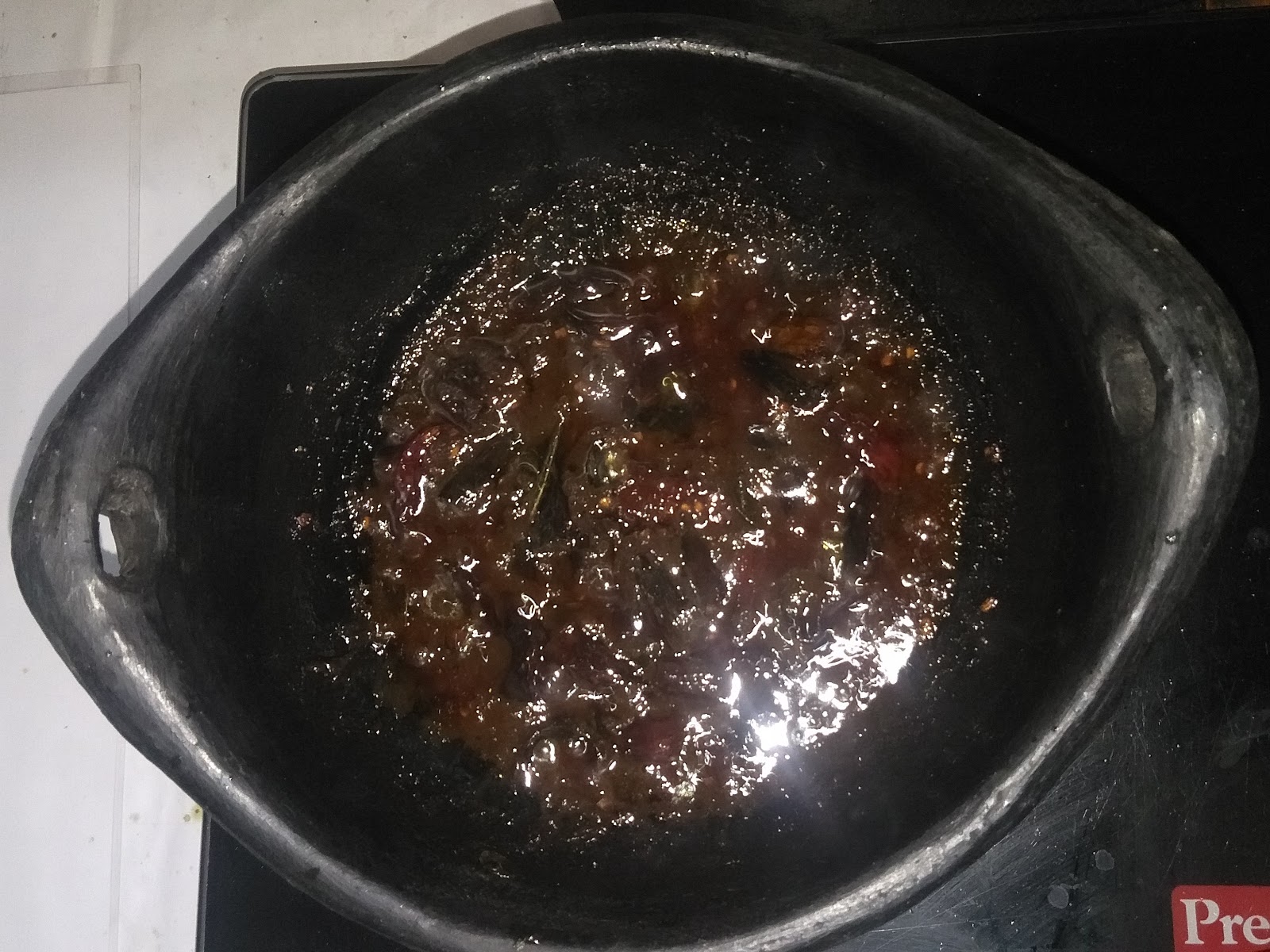
21
Add this tamarind paste to the rice that has been spread on the plate for cooling.
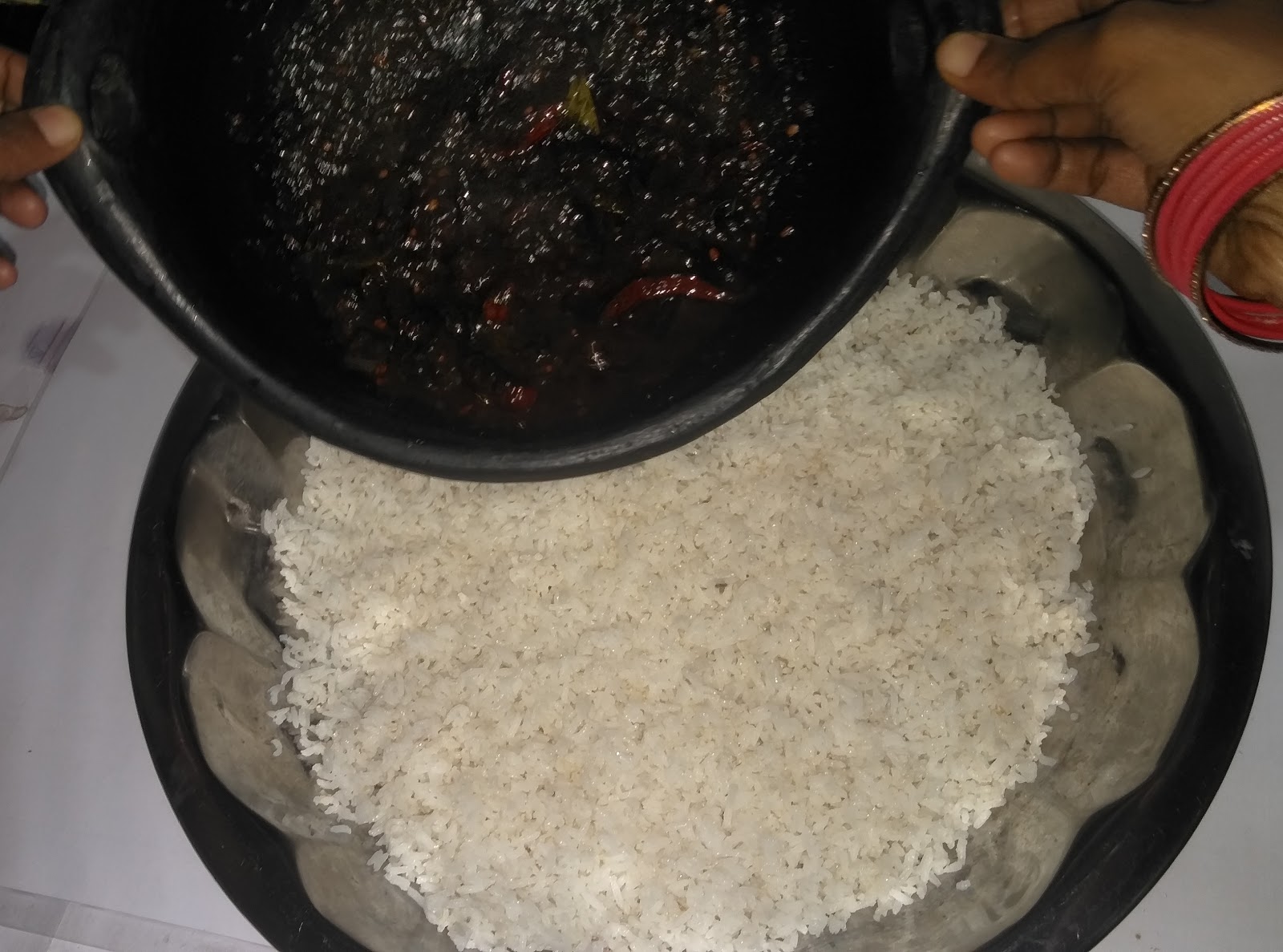
22
Mix thoroughly with the ladle, so that all the ingredients coat the entire rice nicely.
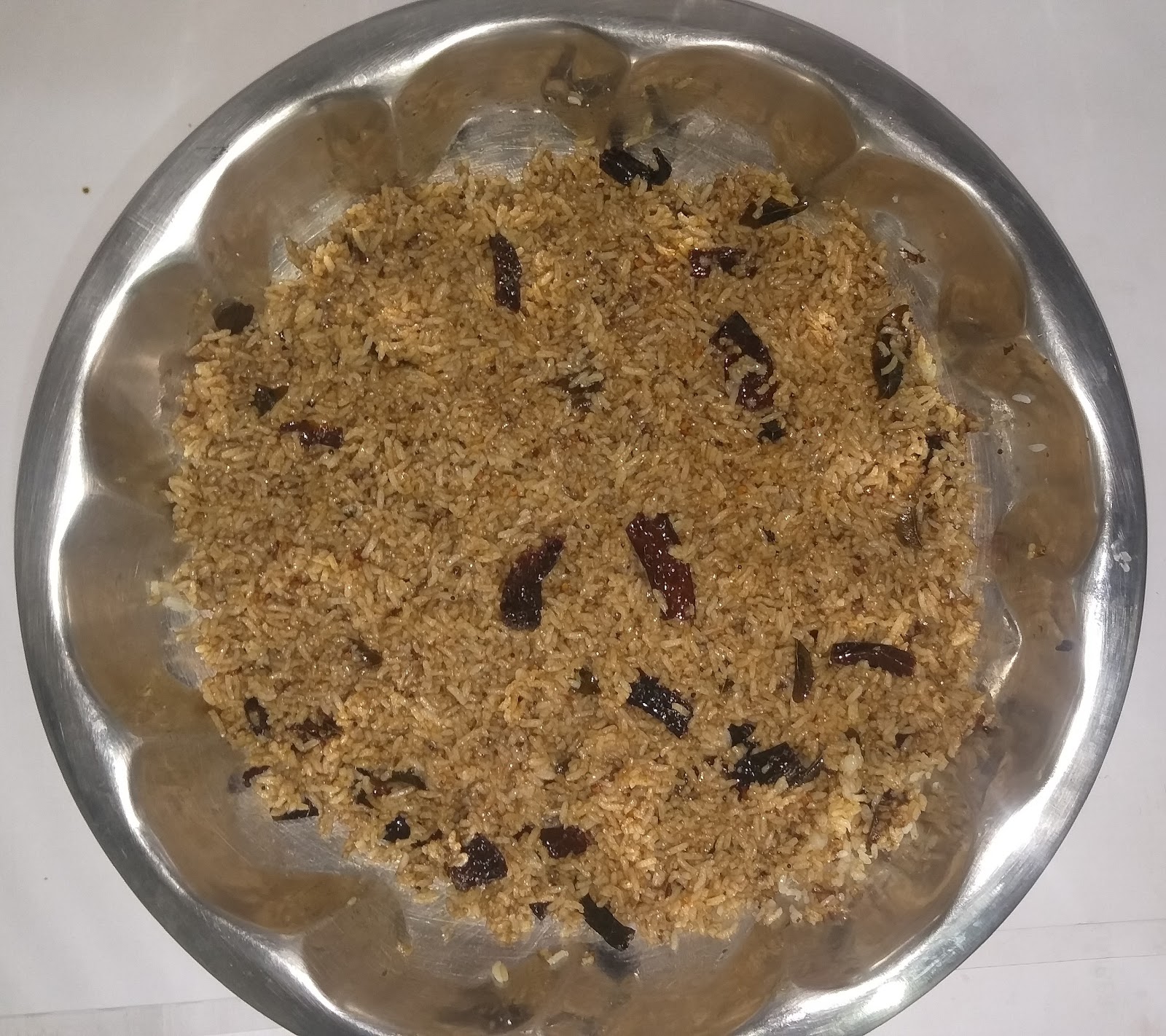
23
Now the tamarind rice is ready to be served. It can be served along with koozh vada or papad for the best taste!


